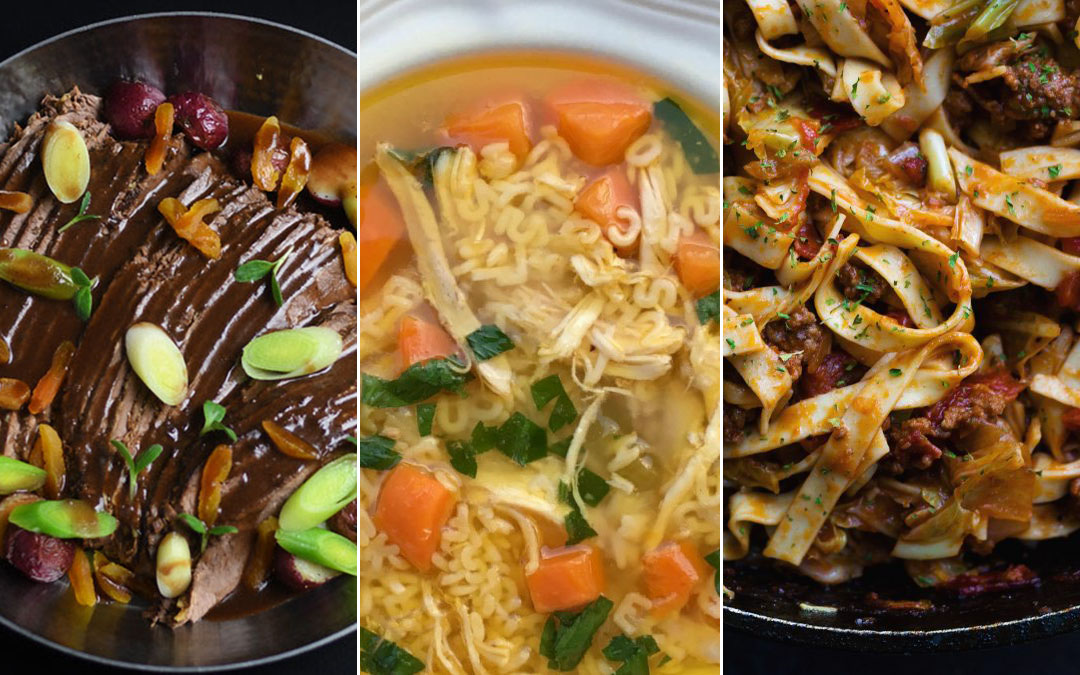It’s the time of year to indulge, hibernate and try to warm up with a hearty bowl of soup or a crock of soothing goodness. Throw caution to the wind and tuck into some of these comfort foods to fill those bellies before you make your New Year’s resolutions.
Here are some of our go-to winter dishes:
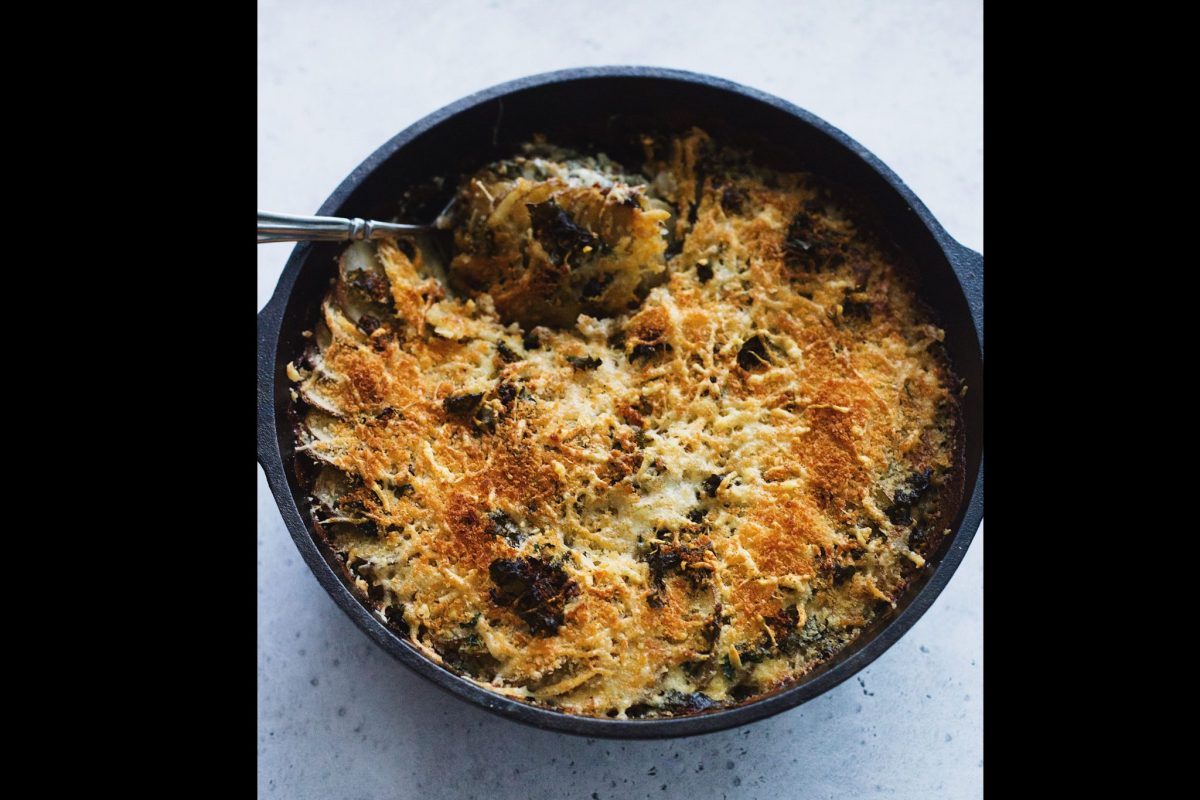
Cheesy Kale and Potato Gratin Recipe
Ingredients
- butter for the dish
- 2 1/2 cups heavy cream
- 2 cloves garlic minced
- 3 bay leaves fresh
- 3 sprigs thyme fresh
- 5 whole black peppercorns
- 1 tbs. mustard seed ground
- 1/4 tsp. nutmeg
- 1 tbs. kosher salt
- 1 tsp. black pepper freshly ground
- 4 lbs. russet potatoes scrubbed and thinly sliced
- 4 cups curly or lacinato kale washed, chopped and stem removed
- 4 oz. Raclette cheese (1 cup) finely grated (can also use gruyere)
- 1/2 cup panko breadcrumbs
Instructions
- Preheat oven to 350 F. Butter the inside of a 3-quart baking dish.
- Bring the heavy cream, garlic, bay leaves, thyme, peppercorns, mustard and nutmeg to a simmer in a small saucepan over low heat. Let cool slightly. Remove bay leaves, thyme and peppercorns from sauce. Season the cream mixture with salt and pepper.
- Fan out a layer of potatoes on the bottom of the buttered casserole dish. Sprinkle with salt and pepper and top with 1 cup of the kale. Pour 1/4 of the cream mixture on top. Sprinkle with 1/4 of the grated cheese mixture. Repeat with 3 more layers, reserving the last 1/4 cup of cheese.
- Bake potatoes until tender and creamy, around 1 hour. Then cover the potatoes with foil and let bake for another 30-35 minutes, or until the cream is bubbling and the potatoes are easily pierced with a fork.
- Place rack in highest position; heat broiler. Mix the breadcrumbs with the remaining 1/4 cup of cheese and sprinkle over the potatoes.
- Broil until cheese is bubbling and top of gratin is golden brown, 7-10 minutes. Serve topped with sprigs of fresh thyme leaves, if desired.
Notes
The Nosher food blog offers a dazzling array of new and classic Jewish recipes and food news, from Europe to Yemen, from challah to shakshuka and beyond. Check it out at www.TheNosher.com.
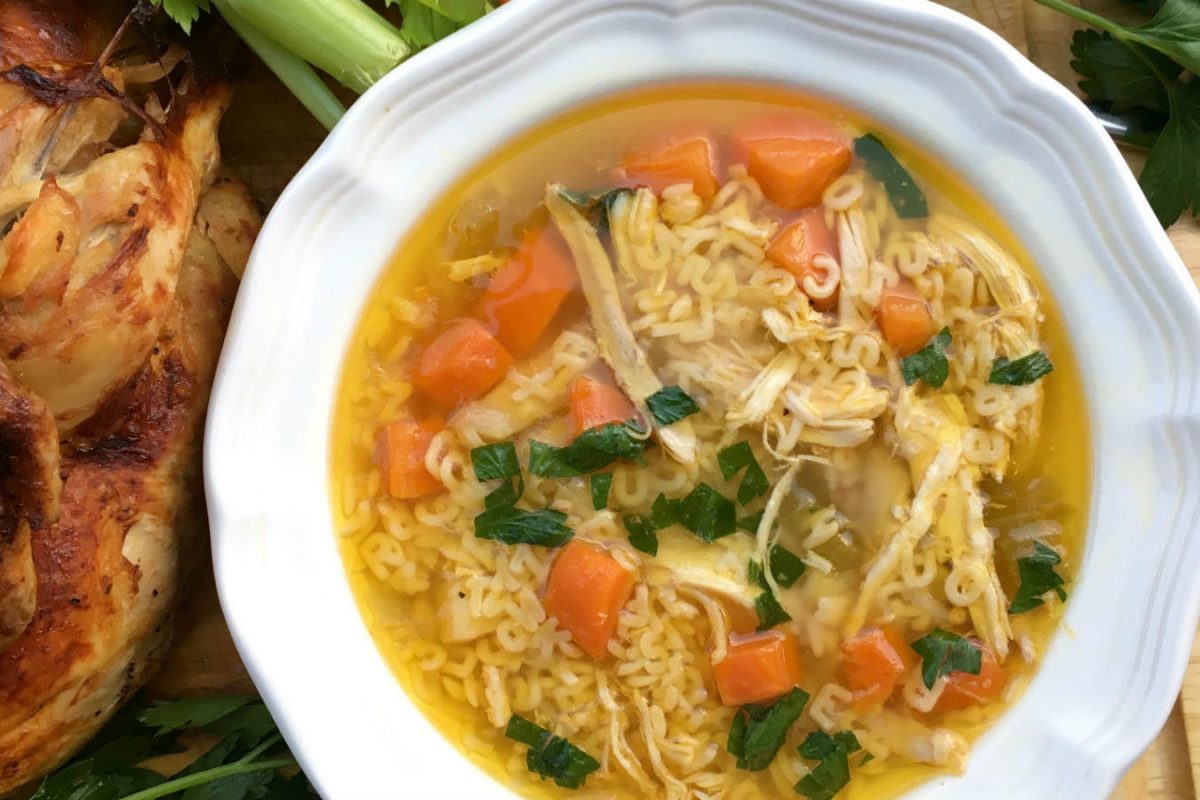
Chicken Soup in an Instant Pot
Ingredients
- 1 tbs kosher salt
- 1 tsp black pepper
- 1/4 tsp turmeric
- 1 tsp paprika
- 1 5-lb chicken whole, giblets removed
- 1 small onion diced
- 2 stalks celery diced
- 2 sticks carrot diced
- 1 parsnip diced
- 4 cloves garlic finely minced
- 6 cups water
- 2 dried bay leaves
- 10 large allspice berries You can find whole allspice berries in the spice aisle. You can also substitute 1/2 teaspoon ground allspice.
- noodles optional
- Italian parsley for garnish
Instructions
- Press saute button on Instant Pot and let the device heat up.
- Combine the salt, pepper, turmeric and paprika, and coat the chicken with the mixture, making sure to get underneath the skin and inside the cavity. Once the Instant Pot is hot, brown the chicken in the pot about 2-3 minutes on each side. Remove chicken and set aside.
- Add onion, celery, carrots, parsnip and garlic to the pot, and saute until onions are translucent, about 3-5 minutes.
- Place the chicken breast-side down on the Instant Pot trivet, and lower it into the pot on top of the vegetables. Pour in water along the sides of the chicken, so as not to wash away the seasonings. Add bay leaves and allspice berries. Cover with the lid, make sure the valve is in place and press the manual button.
- Cook on high pressure for 20 minutes and allow to naturally pressure release (NPR) for 20 minutes. Release the pressure valve and let the pot depressurize completely before opening lid.
- Remove the chicken, bay leaves and allspice berries, and skim the fat layer from the top of the soup. Return the pot to the saute function and add uncooked noodles, if desired. Cook until noodles are al dente.
- When chicken is cool enough to handle, shred the meat from the bones and return to the soup. (Note: Optionally, you can use half the chicken for the soup, and place the other half under your broiler for a few minutes for delicious roasted chicken to eat later.)
- Garnish with Italian parsley and serve immediately.
Notes
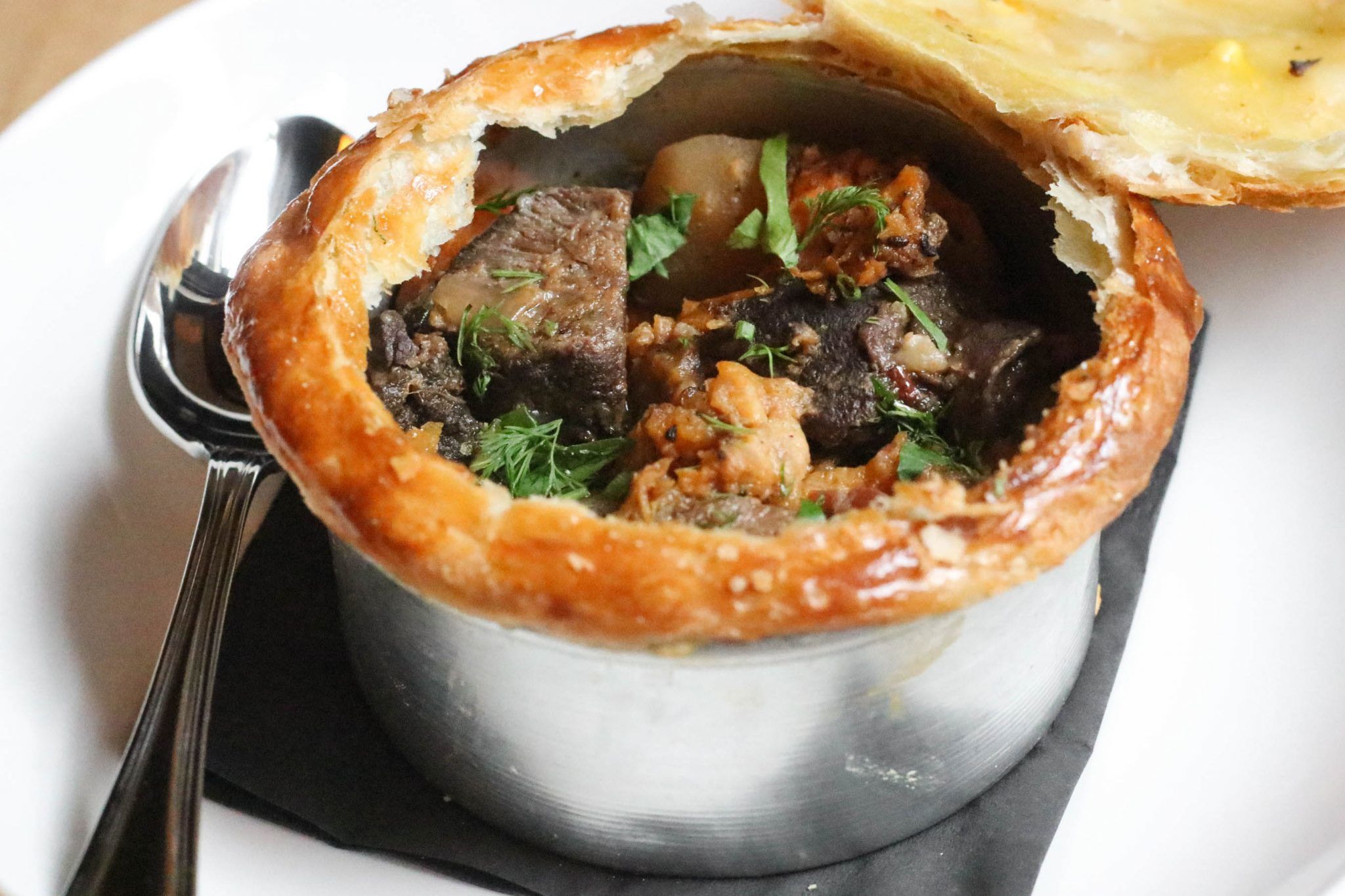
Cholent Pot Pie Recipe
Ingredients
- 1 cup pearled barley
- 1 cup dried kidney beans
- 3/4 lb. boneless short ribs cut into 2-inch cubes
- 1/2 lb. kosher salami cut into 1/2-inch cubes
- 1 large yellow onion cut into 8 wedges
- 1 stalk celery sliced
- 3 cloves garlic minced
- 1 tsp. freshly ground black pepper
- 1 carrot roughly chopped
- kosher salt
- 1/4 cup ketchup
- 1/2 cup red wine
- 1 tsp. ground cumin
- 1 tbs. hot smoked paprika
- 1 cube beef bouillon
- 1 quart water
- 1 sprig fresh rosemary
- 1 sweet potato cut into 1-inch cubes
- 1 Idaho potato cut into 1-inch cubes
- 1/2 cup chopped parsley
- Store-bought frozen puff pastry or pie dough
- 1 large egg beaten
Instructions
- Combine the barley and kidney beans in a large bowl and cover with several inches of water. Let soak overnight in the refrigerator. In the morning, drain and set aside.
- Preheat the oven to 375 F.
- Heat 1 tablespoon of oil in a 4-quart Dutch oven over medium-high heat.
- Season the short ribs with salt and pepper, then add them to the pot and brown on all sides – about 3 minutes per side. Remove the ribs from the Dutch oven and set aside.
- Add the salami to the pot and cook until brown, about 10 minutes. Remove the salami and set aside. Add the onions, celery, garlic, carrot and a small pinch of salt, and cook, stirring occasionally, until the vegetables have softened and are slightly browned, about 8 minutes.
- Add the ketchup and continue to cook for 2-3 minutes until the mixture starts to bubble. Add the red wine and bring to a boil for 1-2 minutes to burn off the alcohol. Add the spices, bouillon cube, water, and stir to combine.
- Return to a boil and add the beans, barley, short ribs, rosemary and potatoes to the pot. The liquid in the stew should be just covering the meat. Remove excess liquid and add additional water as necessary.
- Cover the stew with a lid and place in the oven for about 3 hours or until the short ribs are fork tender. Keep the lid on and let the stew cool in its liquid, then refrigerate overnight.
- The following day, preheat the oven to 375 F. Transfer the stew to a separate pot and simmer on the stove to bring the mixture back to temperature. Pour the warm stew back into the cold Dutch oven, sprinkle parsley over top and drape a sheet of puff pastry over the sides of the Dutch oven. Crimp the dough around the edges of the pot and trim away any excess. Brush the top of the puff pastry with egg wash and sprinkle with salt. Place the stew in the oven and bake for 12-15 minutes until the pastry is golden brown.
- Let stand for 15 minutes and serve.
Notes
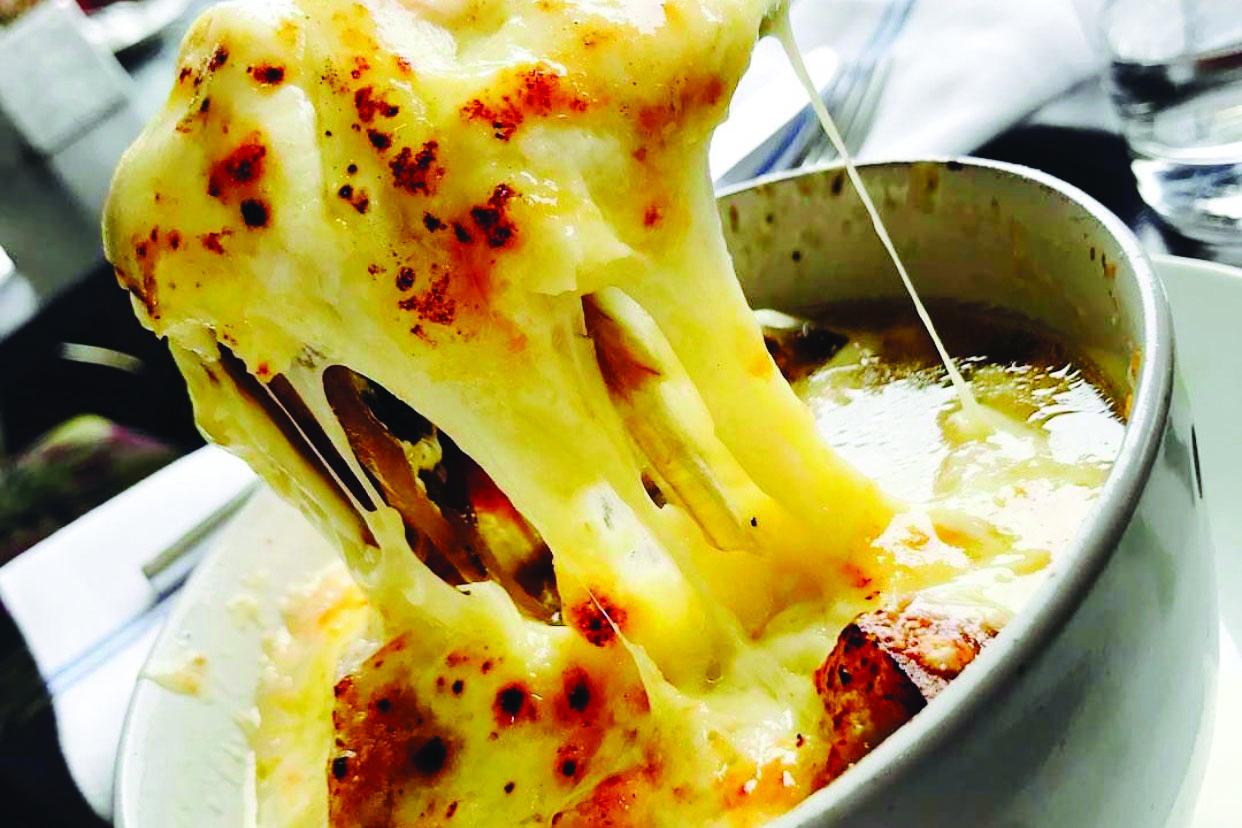
French Onion Soup
Ingredients
- 5 tbs. olive oil
- 1 tbs. butter
- 8 cups yellow onions thinly sliced
- 3 cloves garlic minced
- 1/2 cup port wine
- 2 cartons vegetable broth 32 oz. each
- 1/2 tsp. pepper
- 1/4 tsp. salt
- 12 slices ciabatta bread 1/2 inch thick
- 2 large cloves garlic peeled and halved
- 3/4 cups gruyere and fontina cheese shredded
Instructions
- In a Dutch oven or large pot, heat 2 tablespoons of oil and butter over medium heat. Add onions; cook and stir until softened, 10-13 minutes. Reduce heat to medium-low; cook, stirring occasionally, until deep golden brown, 30-40 minutes. Add minced garlic; cook 2 minutes longer.
- Stir in port wine. Bring to a boil; cook until liquid is reduced by half. Add broth, pepper and salt; return to a boil. Reduce heat. Simmer, covered, stirring occasionally, for 1 hour. Meanwhile, preheat oven to 400°. Place ciabatta slices on a baking sheet; brush both sides with remaining oil. Bake until toasted, 3-5 minutes on each side. Rub toasts with halved garlic.
- To serve, place 2 oven-safe bowls on a baking sheet. Place 2 toasts in each. Ladle with soup; top with cheese. Broil until cheese is melted. Enjoy!!

Harissa Lamb Meatballs Recipe
Ingredients
For the sauce:
- 1-2 tbs. olive oil
- 1 small onion finely diced
- 2 garlic cloves
- pinch caraway seeds
- 2 tbs. tomato paste
- 1 28-oz. can diced tomatoes
- 1 28-oz. can crushed tomatoes
- 3 heaping tbs. harissa paste (you can add more to your taste)
- 1 1/2 cup water
- 1/2 tsp. salt
- 1/4 tsp. black pepper
For the meatballs:
- 2 lbs. ground lamb
- 3 tbs. mint minced
- 3 tbs. minced flat leaf parsley
- 2 garlic cloves minced
- 2 large eggs
- 1 tsp. salt
- 1 tsp. fresh lemon zest
- vegetable oil for frying
Instructions
- To make the sauce: Heat olive oil in a large pot over medium high heat. Saute onion until translucent and soft, around 6-8 minutes. Add garlic, pinch of caraway seeds and tomato paste, and saute another 2 minutes.
- Add canned tomatoes, harissa and water, and bring to a low simmer. Cook for 30-40 minutes, covered over low heat. The tomato sauce will be done when the tomatoes have broken down and the sauce has reduced slightly and is a deep color.
- To make the meatballs: Combine ground lamb, mint, parsley, garlic, eggs, salt and lemon zest in a large bowl. Using your hands, combine until mixed throughout, but take care not to overwork the meat.
- Form tablespoon-sized meatballs, using your hands or a cookie scoop. Roll gently and place on a plate until ready to fry.
- Heat vegetable oil (or other neutral oil) over medium heat in a large saute pan. Fry meatballs in batches until brown, rotating them to ensure they have been browned on all sides.
- Remove from pan. You may need to add a little more oil in between batches.
- Add the lamb meatballs to the sauce (as well as additional liquid from frying) and allow to simmer another 15 minutes.
- Serve with couscous and chopped fresh herbs if desired.
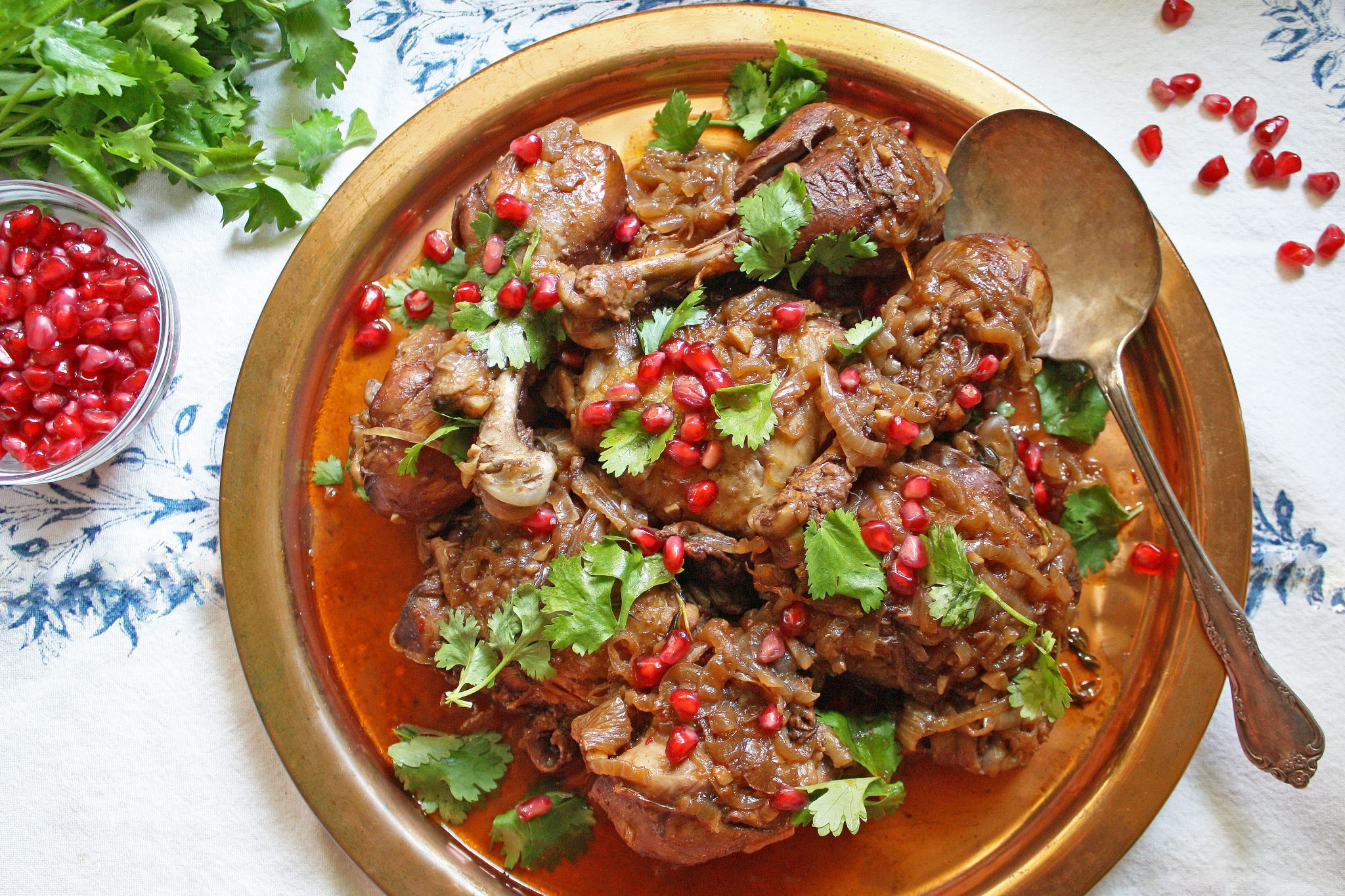
Instant Pot Georgian Pomegranate Chicken Recipe
Ingredients
- 12 whole chicken legs or 6 bone-in thighs plus 6 legs (about 4 pounds)
- sunflower or avocado oil as needed
- 3 medium red onions halved and sliced thin
- 4-5 cloves garlic finely minced
- 2 tsp. ground coriander
- 1 1/2 tsp. aleppo pepper or 1/2 teaspoon red pepper flakes, or to taste
- 1 tsp. sweet paprika
- 2 tbs. tomato paste
- 1 cup pomegranate juice
- 2 tbs. pomegranate molasses
- 2 tbs. tamarind paste
- 1 tbs. honey
- 3 sprigs thyme fresh
- 1 bay leaf
- 1 whole pomegranate arils/seeds only
- 1/2 bunch cilantro fresh, for garnish
- salt and pepper as needed
Instructions
- Start by generously seasoning your chicken with salt and pepper on both sides.
- Turn your Instant Pot or pressure cooker to the saute setting, which should produce high heat for browning. If needed increase the heat to MORE or according to the manufacturer’s instructions. Once the pot is hot, add a drizzle of oil. Brown each piece of chicken until golden brown, about 3-4 minutes on each side. Cook the chicken in batches so as not to crowd the pot and cause the chicken to steam instead of brown. On the stovetop, brown the chicken in a large pot or Dutch oven on medium high heat. Once all of the chicken is browned, transfer it from the pot and reserve.
- Add all of the onions to the same pot, so that they can cook in the remaining chicken fat. If your chicken did not release very much oil, add another tablespoon or two of oil to the pot. Season the onions with salt and saute for 5-6 minutes, or until softened and starting to slightly brown. Add the garlic, coriander and paprika to the pot and saute for an additional 1-2 minutes, or until fragrant. Add the tomato paste and stir everything until the onion mixture is well coated in the tomato paste. Nestle the reserved browned chicken back into the pot. Press CANCEL to turn off the saute function on the pot. Follow the same steps on a stovetop.
- Add the pomegranate juice, pomegranate molasses, tamarind paste, honey, thyme and bay leaf to the pot. Place the lid on the Instant Pot, close the pot and seal it. Press the POULTRY or MANUAL setting and set the time to 15 minutes. Let the steam naturally release for 10-15 minutes, and shift the valve to venting if more air needs to be released. On the stovetop, cover the pot and simmer for 30 minutes on medium-low or until the chicken is tender and cooked through.
- Press CANCEL, open the lid and transfer the chicken to a platter and lightly cover with foil to keep the chicken warm. Remove the bay leaf and thyme stems. Turn on the SAUTE function again. Allow the sauce to simmer and reduce by half, or until it has reached your desired thickness. On the stovetop, turn the heat to medium-high and simmer.
- Once the sauce has reduced and thickened, pour the sauce over the chicken. At this point you can keep dish warm in a low oven, or you can cool it and freeze if making in advance.
- Just before serving, garnish the chicken with the fresh pomegranate and roughly chopped cilantro or parsley.
Notes

Lamb Stew with Pomegranate
Ingredients
- 3 lbs. lamb stew meat cut into 2- to 4-inch pieces
- 1 large onion sliced
- 3 cloves garlic minced
- 1-2 tsp. salt
- 1 tsp. pepper
- 3 sticks cinnamon
- 21/2-3 cups water or stock
- 3 tbs. pomegranate molasses plus extra for drizzling
- 1 cup pomegranate seeds divided
- fresh parsley, mint or cilantro for serving
Instructions
- Heat a heavy casserole with a little oil over medium-high heat. Sear lamb pieces on each side until lightly golden.
- Remove lamb.
- Add onion and saute until translucent. Add garlic and saute for another 3 minutes.
- Place lamb back into the pot and add salt, pepper, cinnamon stick, pomegranate molasses and half the pomegranate seeds.
- Add 2 to 2 1/2 cups water or stock, until meat is cover. Bring to a boil.
- Reduce the heat to low-medium, cover and continue to cook over low heat for about 2 hours. Check on stew periodically, and add more water if needed. Lamb should be fork tender when it is done.
- Serve stew over couscous or rice. Drizzle top of stew with additional pomegranate molasses (around 1-2 tablespoons), the remaining pomegranate seeds and freshly chopped herbs such as parsley, mint and/or cilantro.
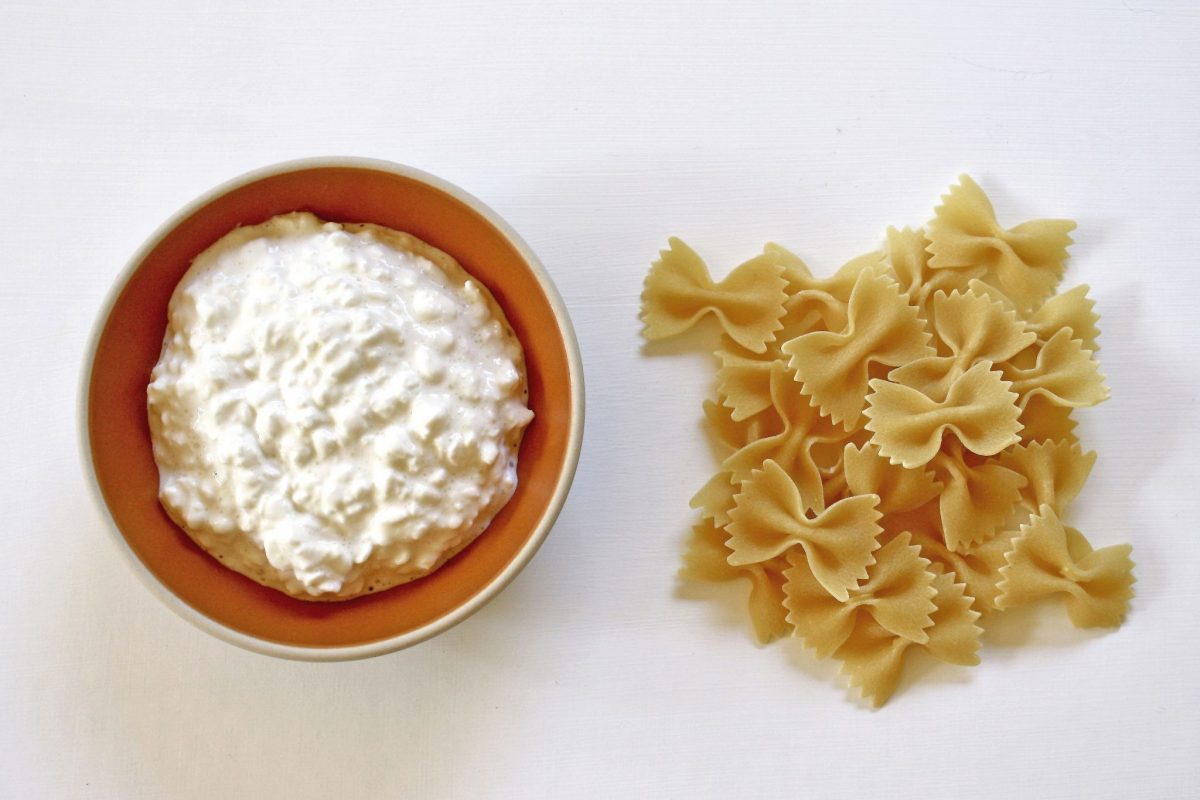
Noodles and Cottage Cheese
Ingredients
- 1 16-oz. package pasta penne, bowties, egg noodles, etc.
- 1 16-oz. container small curd cottage cheese
- 3-4 tbs. sour cream optional
- salt and pepper to taste
Instructions
- Bring a large pot of salted water to a boil, and cook the pasta according to the package instructions.
- Once cooked, drain the pasta well and add it back to the hot pot.
- Add the cottage cheese to the pasta and stir until all of the noodles are well coated.
- Add sour cream, if using, and salt and pepper to taste. Stir until well combined.
- Serve hot, and if desired garnish the dish with fried onions, parmesan cheese, and/or chopped parsley.
Notes
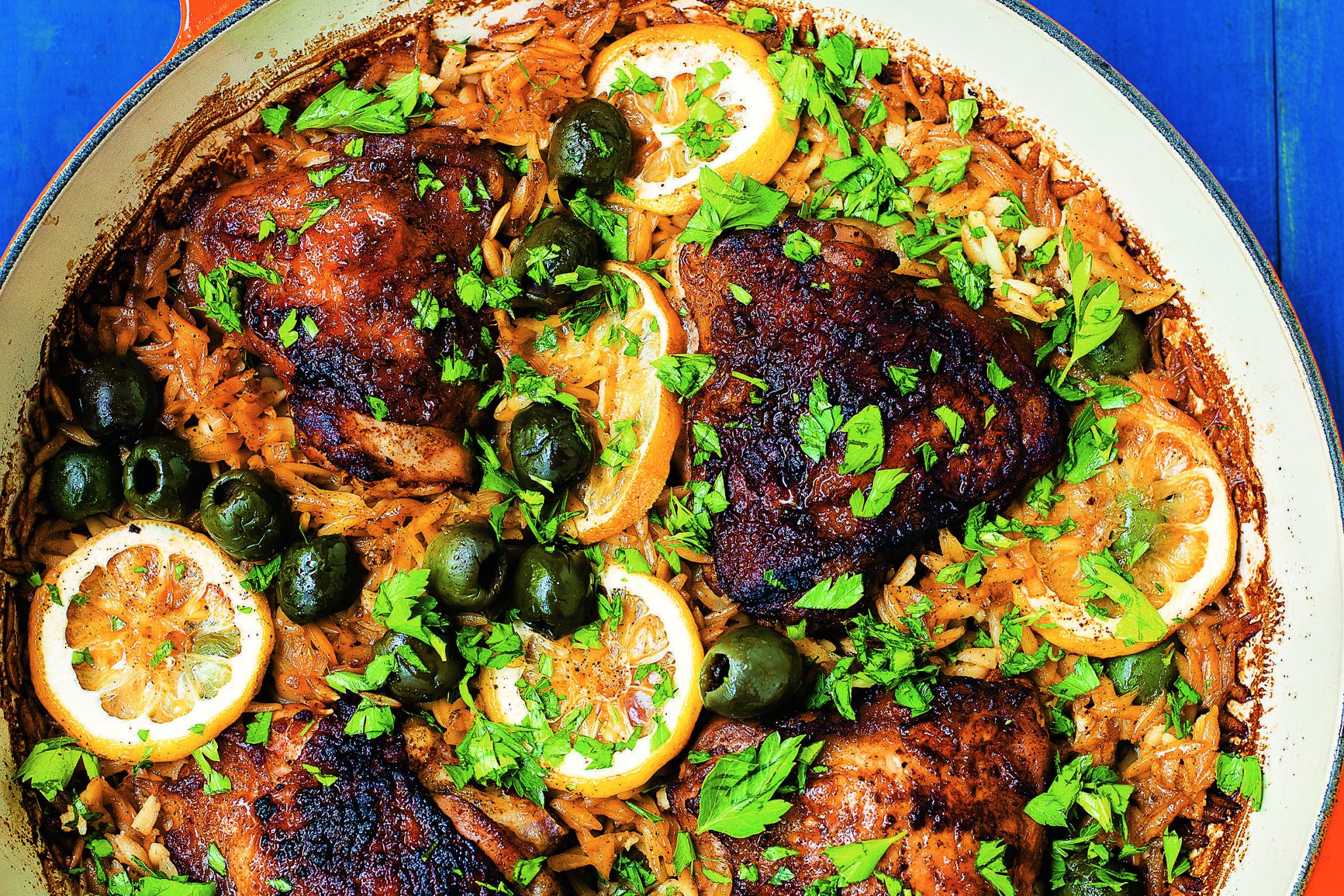
One Pot Paprika Chicken with Orzo and Olives Recipe
Ingredients
- 2 lb. chicken thighs, bone-in and skin-on
- 2 tsp. smoked paprika
- 1/2 tsp. salt
- olive oil as needed
- 1 shallot chopped finely
- 2 garlic cloves chopped finely
- 8 oz. orzo dried
- 2 cups chicken stock
- 1 lemon sliced
- 1 cup Castelvetrano olives whole pitted
- parsley chopped, for garnish
Instructions
- Preheat the oven to 350 F.
- In a bowl, toss the chicken with the paprika and salt, making sure the spices evenly coat the chicken.
- Heat a large skillet over medium-high heat and add enough olive oil to coat the bottom. Don’t add too much oil because the chicken will give off its own fat, as well.
- Once the oil is hot, place the chicken thighs skin-side down into the hot pan and cook until a deep golden brown, about 3 to 4 minutes, and then flip the chicken over to the other side and cook for an additional 3 minutes.
- Once both sides of the chicken are a deep golden brown, remove to a plate and set aside.
- In the same hot skillet, add the shallot and saute until lightly golden, about 2 to 3 minutes. Add the garlic and saute for another minute.
- Add the orzo and stir so it is coated in the oil and aromatics (this will give it great flavor). Use a spatula to even out the orzo. Add the chicken back into the pan, skin-side up and pour in the stock.
- Scatter the lemon slices and olives over the chicken and orzo and place in the oven, covered, for 25 minutes. Remove the cover and continue cooking for an additional 12 to 15 minutes.
- Once cooked, remove from the oven and garnish with parsley.
Notes
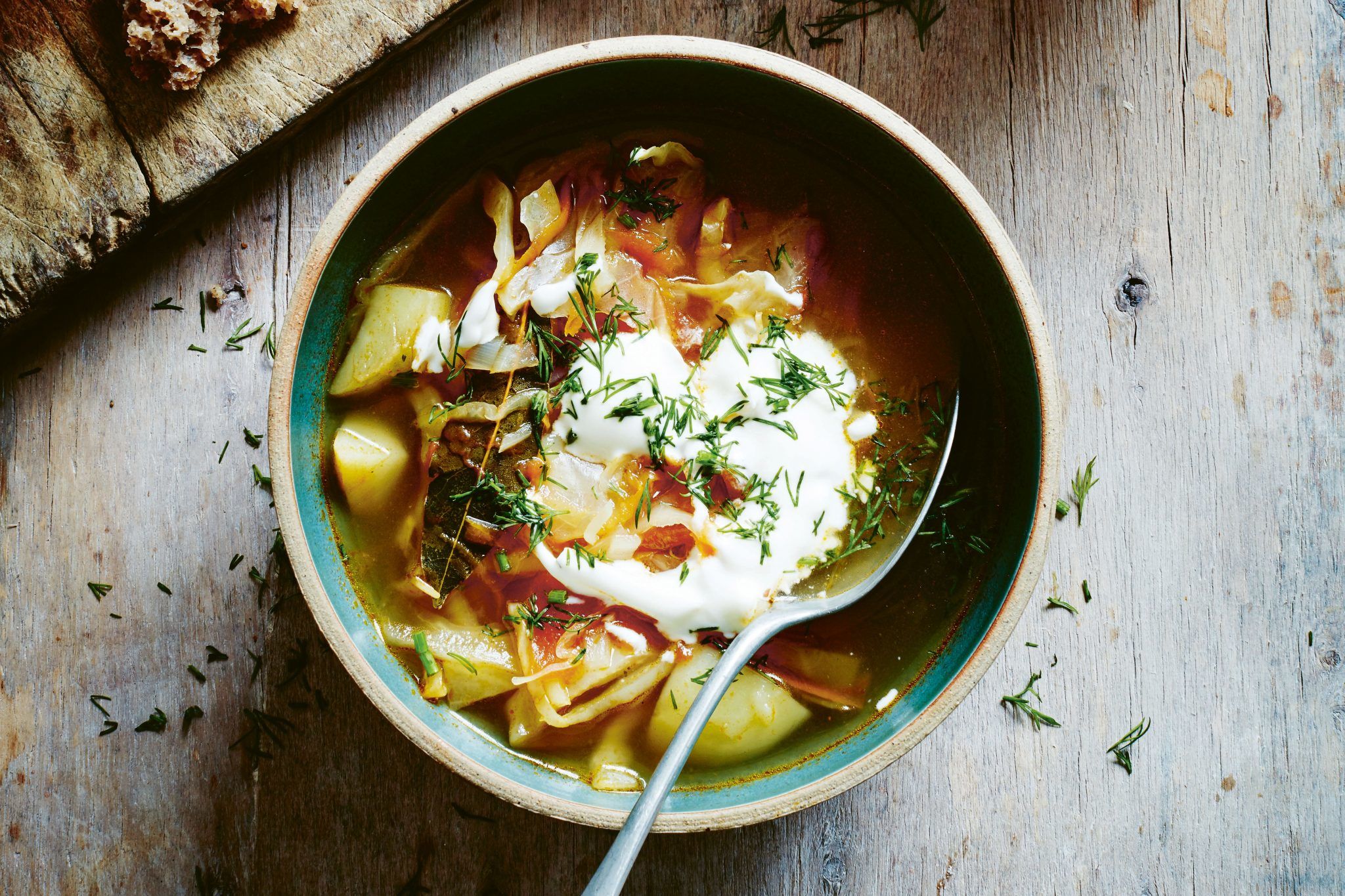
Russian Cabbage Soup
Ingredients
- 2 tbs. butter
- 1 large onion finely chopped
- 2 cloves garlic finely chopped
- 1 lb. green or white cabbage finely shredded
- 1 medium carrot coarsely grated
- 2 medium starchy potatoes peeled and diced
- 4 ripe plum tomatoes peeled, de-seeded and chopped
- 2 bay leaves
- 4 cups vegetable stock or water
- salt and freshly ground black pepper
- 2 tbs. finely chopped dill or parsley
- Sour cream for serving
Instructions
- Heat the butter in a large saucepan and add the onion and garlic. Cook over a moderate heat until the onion is translucent.
- Add the cabbage and carrots, and continue to cook for a few minutes, stirring from time to time so the vegetables cook evenly.
- Add the potatoes, tomatoes, bay leaves and stock; bring to the boil. Season with salt and pepper, then cover and simmer for another 20-25 minutes, adding a little water if the soup seems too thick.
- Serve hot in individual bowls garnished with dill or parsley and a dollop of sour cream. Serves 4.
Notes
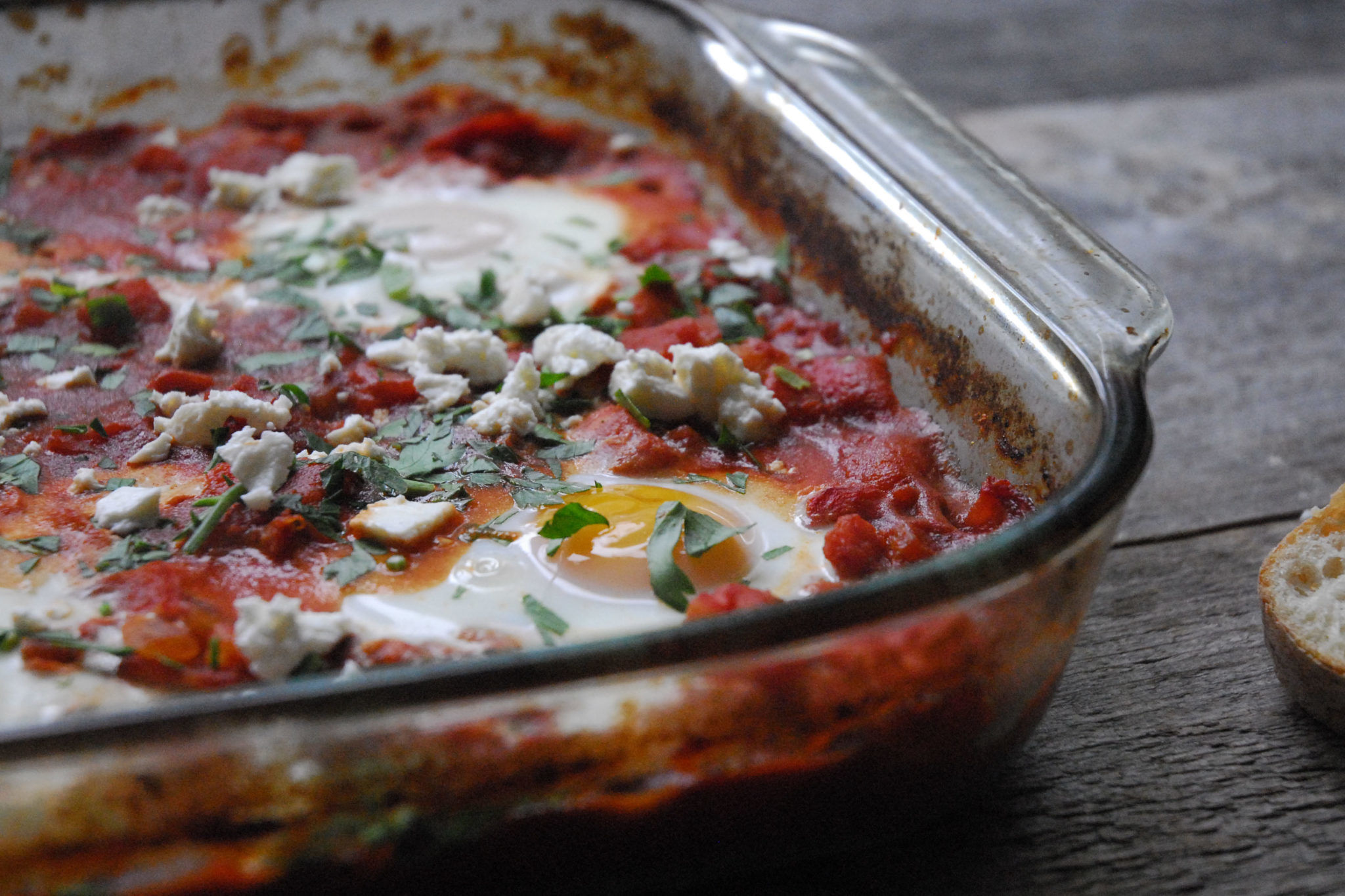
Shakshuka for a Crowd
Ingredients
- 2 tbs. olive oil
- 1 large onion
- 4 cloves garlic
- 1 12-oz. jar roasted red peppers, drained and chopped (can also use freshly roasted peppers, skin removed and chopped)
- 2 28-oz. cans diced tomatoes
- 1 tbs. paprika
- 2 tsp. cumin
- 1/2 tsp. caraway seeds
- salt and pepper to taste
- 6-8 eggs
- 2-4 oz. feta cheese
- 2 tbs. chopped fresh parsley
- pita or fresh bread for serving
Instructions
- Preheat oven to 375 F. Grease a 9-by-11 Pyrex dish.
- Add oil to a large saute pan (pan should be a little on the deeper side) over medium heat. Add onion and cook for 4-5 minutes, until soft and translucent. Add garlic and cook 1 minute. Add roasted bell pepper and spices and continue to cook for 3-4 minutes, until fragrant.
- Scrape mixture into greased Pyrex dish. Add the 2 cans of diced tomatoes and mix.
- Place in oven for 30-35 minutes, until sauce has thickened slightly and tomatoes are cooked.
- Carefully remove pan from oven. Using a tablespoon, create 6-8 wells in the tomato sauce. Crack eggs and gently place in each well.
- Place pan back into oven for 3-5 minutes, or until whites have just set and egg yolks are still runny. (Or to your liking).
- Remove from oven. Sprinkle with feta cheese (optional) and fresh parsley. Serve hot with fresh pita or bread.
Notes

Slow Cooker Pot Roast Recipe
Ingredients
- 1 5-lb. boneless beef chuck roast
- 1 1/2 tsp. kosher salt (or more, to taste)
- 1 tsp. fresh ground black pepper (or more, to taste)
- 2 tbs. olive oil
- 2 large sweet onions diced
- 2 large carrots diced
- 4 cloves garlic finely minced
- 1 large sprig rosemary
- 12 oz. cremini mushrooms chopped
- 1 15-oz. can low sodium beef broth
- 1 28-oz. can diced tomatoes
- 1 dried bay leaf
Instructions
- Pat the beef chuck roast dry, and season with salt and pepper. In a large saute pan, heat the olive oil, and brown the beef on all sides (about 3 minutes per side).
- While the beef is browning, layer the onions, carrots, garlic, rosemary and mushrooms in the bowl of a slow cooker. Once the beef is browned on all sides, place the beef on top of the vegetables in the slow cooker.
- Deglaze the saute pan with the beef broth, making sure to scrape up any dark spots from the pan. Pour the broth in the slow cooker.
- Pour the diced tomatoes over the beef and tuck in a dried bay leaf.
- Cover and cook on low for 7 hours.
- Remove the beef from the slow cooker using kitchen tongs, and set on a carving board. Shred or slice, and serve with a starchy side dish. Or, you can remove the sprig of rosemary and the bay leaf and blend the vegetables into a thick sauce that can be used as a gravy.
Notes
The Nosher food blog offers a dazzling array of new and classic Jewish recipes and food news, from Europe to Yemen, from challah to shakshuka and beyond. Check it out at www.TheNosher.com.
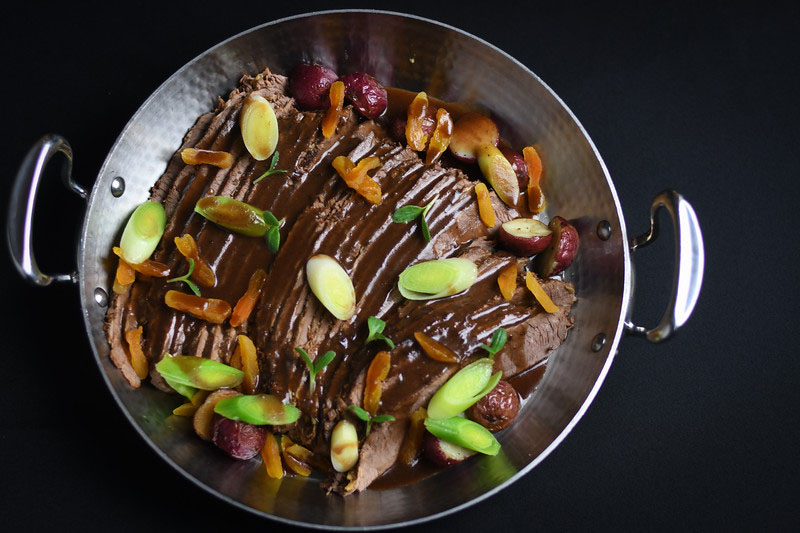
Spiced Brisket with Leeks and Dried Apricots
Ingredients
- 2 tbs. extra-virgin olive oil
- 2 tsp. coarse kosher salt
- 1 tsp. ground black pepper
- 4 1/2-5 1/2 lb. flat-cut (first-cut) brisket well-trimmed
- 2 medium leeks (white and pale green parts only), sliced
- 1 medium onion chopped
- 24 whole whole dried apricots divided
- 5 cloves garlic peeled
- 6 sprigs fresh thyme
- 2 bay leaves
- 2 cups dry red wine
- 2 quarts beef broth
Instructions
- Stir first 3 ingredients in a small bowl.
- Arrange brisket in a large roasting pan; spread spice mixture evenly over both sides. Cover and refrigerate overnight.
- Preheat broiler.
- Uncover brisket.
- Broil until brown, about five minutes per side. Turn brisket fat side up in pan.
- Set oven temperature to 325°F.
- Sprinkle leeks, onion, apricots, garlic, thyme and bay leaves around brisket.
- Pour wine and beef broth over.
- Cover pan with heavy-duty foil and bake brisket until tender, about 2 1/2 hours.
- Uncover; cool for 1 1/2 hours.
- Transfer brisket to work surface.
- Pour juices into a large measuring cup.
- Spoon off fat, reserving 1 tablespoon.
- Thinly slice brisket against grain on slight diagonal; overlap slices in a 15x10x2-inch glass baking dish.
- Spoon 1 cup of degreased pan juices over brisket; cover with foil.
- Stir reserved 1 tablespoon of fat in medium saucepan over medium heat for three minutes.
- Add remaining degreased pan juices; add remaining 12 apricots.
- Simmer until sauce thickens and boils, stirring occasionally for about three minutes.
- Season to taste with salt and pepper.
- The brisket can be made two days ahead of time.
- Cover brisket and sauce separately and chill.
- Rewarm covered brisket in 350°F oven 30 minutes or 45 minutes if chilled. Rewarm sauce over low heat. Serve with sauce.

The Best Vegetarian Matzoh Ball Soup Recipe
Ingredients
For the soup:
- 2 tbs. extra-virgin olive oil
- 4 tbs. tomato paste
- 16 fresh shiitake mushrooms thoroughly washed, stems and caps separated and caps sliced
- 1-1 1/2 tsp. salt (adjust to taste)
- 1/2 tsp. turmeric
- 1/4 tsp. black pepper
- 3 medium carrots cut into chunks
- 1 large parsnip cut into chunks
- 1 yellow onion unpeeled, quartered
- 1 red onion unpeeled, quartered
- 3 celery stalks cut into chunks
- 1 head garlic unpeeled, cut in half width-wise
- 1 bunch fresh dill
- 1 bunch parsley
For the matzoh balls:
- 1 pack matzoh ball mix prepared according to directions (or make homemade)
Instructions
- Heat the olive oil in a large soup pot.
- Add the tomato paste and cook for 2 minutes over medium high heat, stirring constantly. Add the sliced shiitake mushroom caps, stir well and cook for another minute.
- Add 10 cups water, salt, turmeric and pepper (don’t add all the salt at once here, you can adjust to taste later).
- Place the shiitake stems, carrots, parsnip, onions, celery, garlic, dill and parsley in a cheese cloth. Tie it well with kitchen twine and place it in the soup pot. Bring to a boil and let it cook for 5 minutes.
- Cover, reduce heat to medium low and simmer for an hour. The broth should be ready and should be flavorful. If it’s not, continue cooking for another 15-20 minutes.
- While soup cooks, prepare the matzoh balls following the package instructions.
- Remove cheesecloth from the soup and place it in a colander with a bowl underneath. Squeeze as much liquid as you can from the cheesecloth and pour it into the soup pot (the liquid will be hot, so use a wooden spoon or another utensil). Discard vegetables.
- Prepare matzoh ball according to directions on the box, and chill in fridge for 30 minutes. Or, you can make a homemade version.
- Place the matzoh balls directly into the broth and cook, covered, for 20 minutes.
Notes
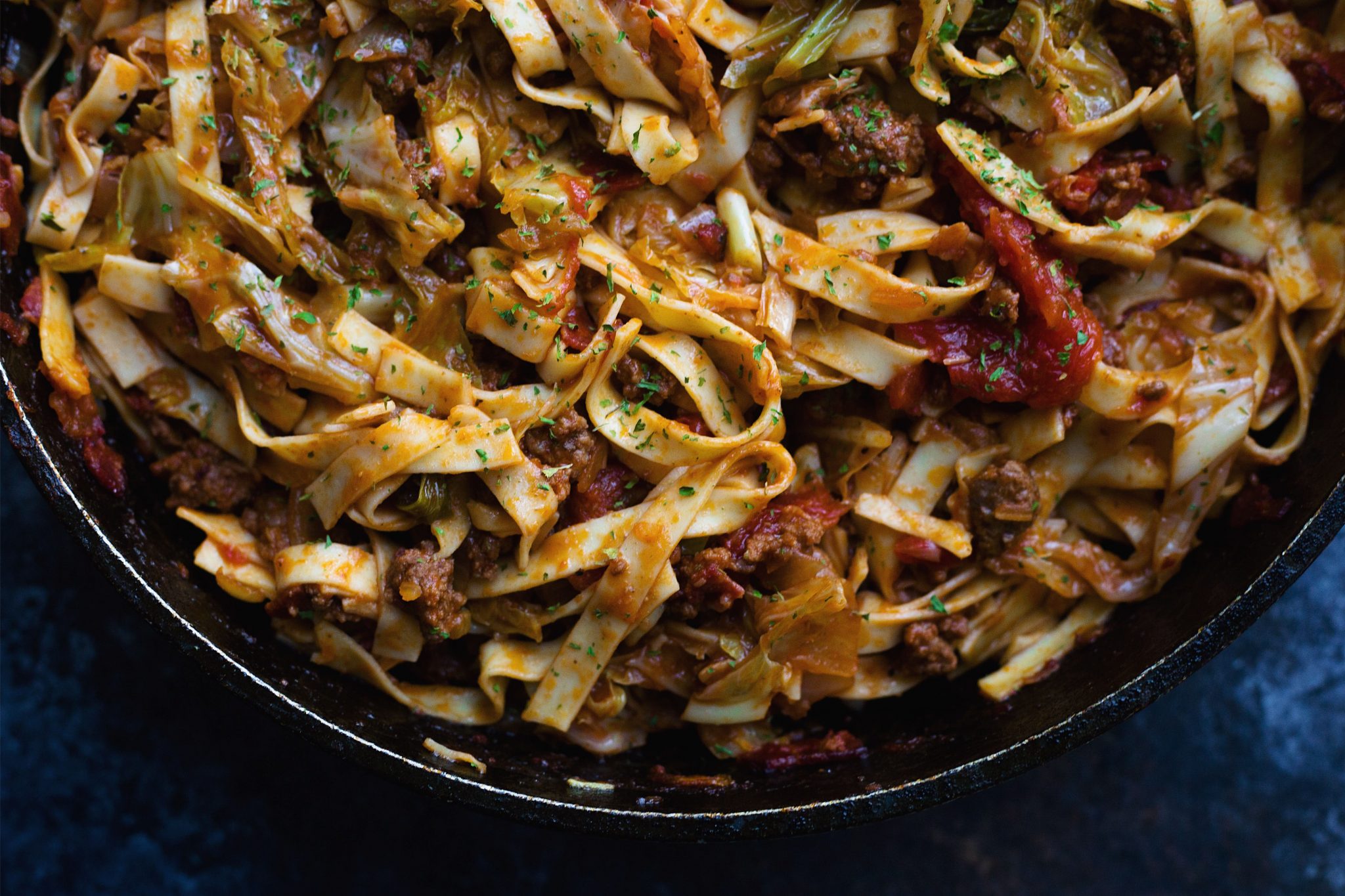
The Ultimate Stuffed Cabbage Hack
Ingredients
- 8 oz. beef bacon chopped into 1-inch pieces
- 1 large yellow onion finely chopped
- 2 cloves garlic finely minced
- 1 medium cabbage core removed and chopped
- 1 lb. ground beef
- 1 28-oz. can crushed tomatoes
- 1 tbs. tomato paste
- 1 tbs. sugar
- 1/4 tsp. crushed red pepper flakes
- 2 bay leaves dried
- 12 oz. uncooked egg noodles
- salt and pepper to taste
- parsley dried or fresh, for garnish
Instructions
- In a large skillet over medium heat, fry the chopped "bacon" until crisp and browned. Remove and place on a paper towel-lined plate.
- Add the onion, garlic and chopped cabbage to the same skillet with the bacon fat and cook for 7-10 minutes on medium heat, until the onion is lightly browned and softened and the cabbage is wilting. Transfer the mixture and set aside.
- Turn heat up to high and add the ground beef to the skillet. Cook, breaking up the beef with a wooden spoon as you go, until browned.
- Add the crushed tomatoes, tomato paste, sugar, crushed red pepper flakes and bay leaves to the skillet. Stir to combine with the beef, cabbage and onion.
- Add the beef bacon back to the pan, bring to a simmer, then turn down to medium so it bubbles gently. Cook for 10 minutes uncovered, then simmer for another 10-15 minutes, covered. Remove the bay leaves.
- Meanwhile, cook the egg noodles according to package directions. Drain and set aside. Taste the beef and cabbage mixture and season with salt and pepper as desired.
- Combine the beef and cabbage sauce with the noodles. Garnish with parsley.
Notes
The Nosher food blog offers a dazzling array of new and classic Jewish recipes and food news, from Europe to Yemen, from challah to shakshuka and beyond. Check it out at www.TheNosher.com.
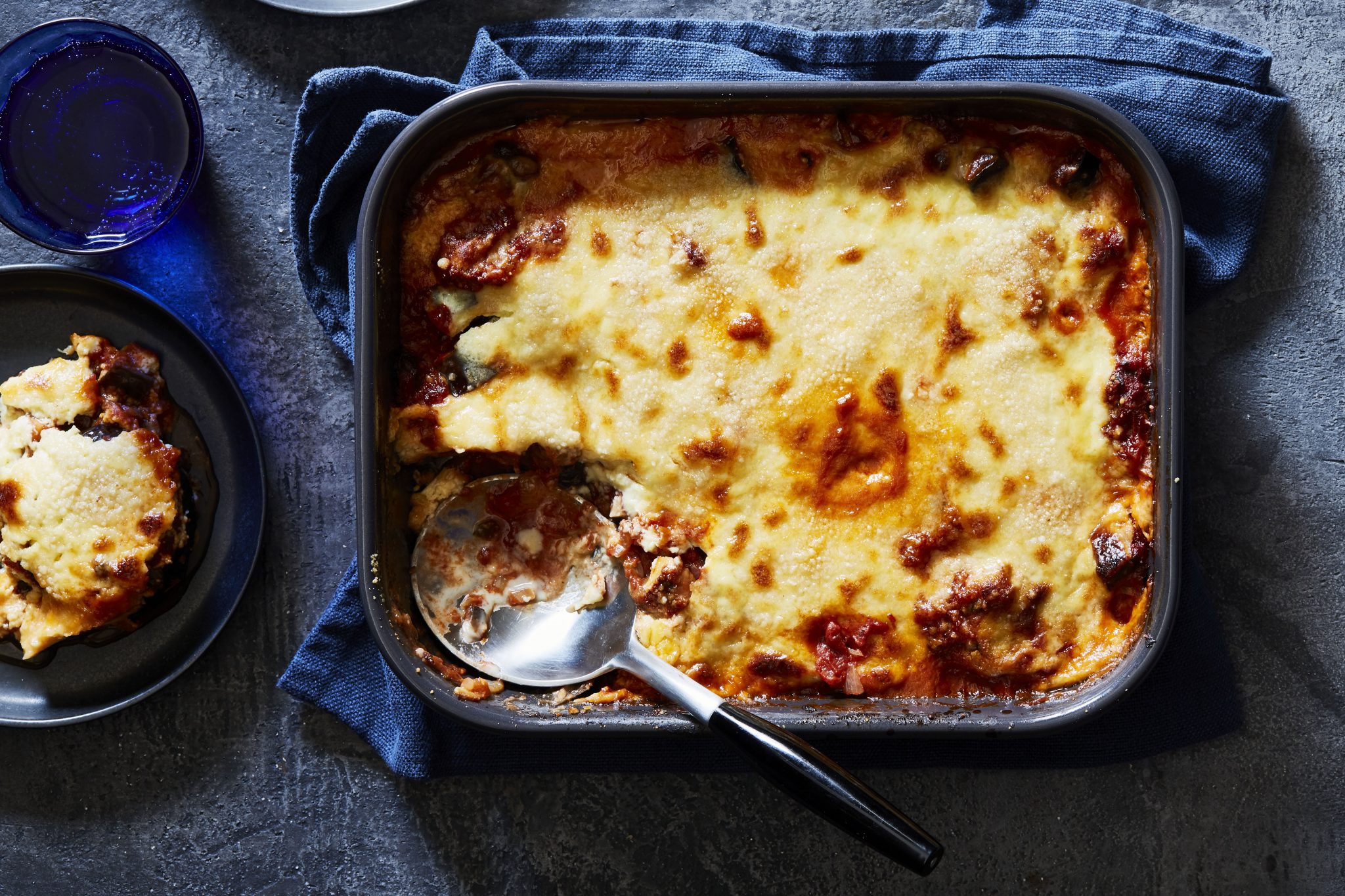
Vegetarian Mushroom Moussaka Recipe
Ingredients
- 1/4 cup extra-virgin olive oil plus about 3/4 cup for greasing and brushing
- 4 small eggplants (about 1-pound each), peeled
- kosher salt
- freshly ground black pepper
- 2 medium onions finely chopped
- 1 lb. cremini mushrooms stemmed and cut into 1/2-inch pieces
- 6 cloves garlic minced or pushed through a press
- 1 tbs. dried oregano
- 1 tsp. ground cinnamon
- 1/4 tsp. ground allspice
- 1 28-oz. can crushed tomatoes
For the bechamel sauce:
- 6 tbs. unsalted butter
- 1/2 cup all-purpose flour
- 3 cups milk
- 1 cup Parmesan cheese finely grated
- kosher salt
- freshly ground black pepper
- 3 egg yolks
Instructions
- Make the base and sauce: Preheat the oven to 400 F. and generously grease 2 large-rimmed baking sheets with about 3 tablespoons of olive oil each. Slice 3 of the eggplants into 1/2-inch-thick rounds. Arrange the eggplant slices in a single layer on the sheets, brush the tops generously with more oil, and season with salt and pepper. Bake, flipping the eggplant pieces once, until softened and lightly browned, 20 to 25 minutes. Remove from the oven and set aside. Lower the oven temperature to 350 F.
- Meanwhile, chop the remaining eggplant into 1/2‑inch cubes. Heat the 1/4 cup of oil in a large saute pan set over medium heat. Add the onions and a pinch of salt and cook, stirring occasionally, until soft and translucent, 5 to 7 minutes. Add the chopped eggplant and mushrooms, turn the heat to medium-high, and cook, stirring occasionally, until the vegetables are very tender and the liquid has cooked off, 10 to 15 minutes. Stir in the garlic, oregano, cinnamon and allspice, and cook until fragrant, about 1 minute. Stir in the crushed tomatoes, 1 teaspoon salt and 1/2 teaspoon pepper. Turn the heat to medium and simmer until slightly thickened, 5 to 10 minutes. Taste and add more salt and pepper, if desired.
- Make the bechamel: Melt the butter in a medium saucepan set over medium heat. Add the flour and whisk until fully combined, then slowly whisk in the milk. Simmer, whisking constantly, until the sauce thickens enough to coat the back of a spoon, 5 to 10 minutes. Whisk in about half of the Parmesan, 1 teaspoon salt and a generous amount of pepper. In a separate small bowl, whisk the egg yolks until smooth. Whisking constantly, slowly drizzle about 1/2 cup of the hot bechamel into the yolks. Turn the heat under the saucepan to medium-low and slowly whisk the tempered egg mixture back into the bechamel. Remove from the heat.
- Assemble the moussaka: Grease the bottom of a 9-by-13‑inch baking dish. Layer half of the eggplant slices in the bottom of the baking dish and cover with half of the sauce. Layer the remaining eggplant slices into the dish and cover with the remaining sauce. Evenly pour the bechamel over the top, smoothing with a rubber spatula. Sprinkle with the remaining Parmesan.
- Bake until bubbling and golden brown on top, 20 to 25 minutes. Remove from the oven and let stand for 15 minutes before serving. Serve hot. Store leftovers, covered, in the fridge for up to 3 day
Notes
Cacio e pepe’s sharp cheese and smack of black pepper are a nice balance to eggy-creamy matzah brei.
Dara Bunjon talks with journalist, historian and chef Ramin Ganeshram, author of "The General's Cook," a novel about Chef Hercules Posey's time at George Washington's Mt. Vernon.
This year, Eddie's -- owned and operated by the Cohen family for nearly eight decades -- is offering three Pesach dinner packages, each with a different main course.
With her documentary, local journalist Rona Kobell explores the environmental and social conditions of the Eastern Shore's Deal Island.

